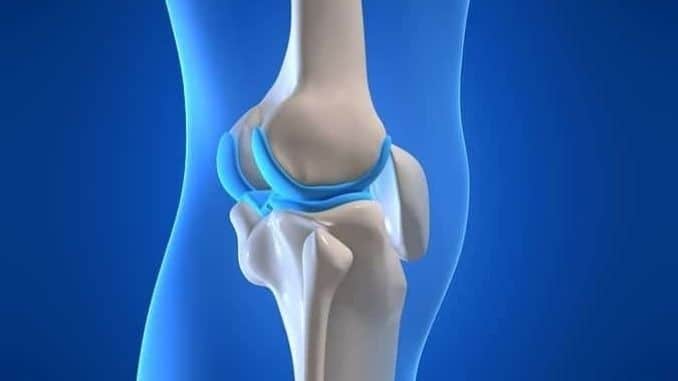
Your knees support the vast majority of your bodyweight and take the brunt of the impact from walking, running and jumping. Keeping your knee joints healthy is vital to performing nearly any activity pain-free. Unfortunately, millions of people suffer from knee pain. In fact, according to the Agency for Healthcare Research and Quality, more than 600,000 knee replacements are performed each year in the United States. While it may be comforting to know that knee replacement surgery is considered one of the most successful medical procedures performed, maintaining healthy knees in any way possible is certainly a preferable outcome. Let’s look into what healthy knees are like and why so many people suffer from knee pain.
What a Healthy Knee Joint Looks Like
Knee joints are the largest joints in the human body and are classified as hinge joints. Hinge joints are those that connect two major bones like the femur and the tibia and allow movement in a forward and back range of motion. Within the knee joint, there are ligaments, cartilage, the patella and the menisci.
When functioning properly, these components of the knees work together to make nearly all human activity possible. The cartilage protects the bones from rubbing against each other and allows for smooth movement of the joint while the menisci, located between the femur and tibia, act like shock absorbers to cushion the joint from the impact. The large ligaments that hold the femur and tibia together provide stability to the joint, and the muscles of the legs provide the strength necessary to enable mobility.
The rest of the surfaces of the knee joint are covered by a thin lining called the synovial membrane. This membrane releases a lubricant onto the cartilage that reduces friction in a healthy knee to nearly zero. A strong and healthy knee functions like a well-oiled machine allowing the human body to perform high-intensity activities like jumping, hiking, climbing and more without pain.
However, most people will experience some form of knee pain in their lives and many will find it debilitating. Both disease and injury can affect the knee joints causing loss of function, pain and weakness of the joint.
Why Knees Weaken and Common Injuries
There are many reasons why we feel pain in the knee joints. The knees carry nearly all of our weight with every step we take. When muscle imbalances, disease or injury strike, it can be difficult to recover quickly full functionality since the knees are so vital to everyday movement.
The most common reason for chronic knee pain is arthritis. The three main forms that arthritis takes in the knees are osteoarthritis, rheumatoid arthritis and post-traumatic arthritis. Osteoarthritis is age-related pain and stiffness that is the result of wear and tear on the knees, which affects many people aged 50 and older. Rheumatoid arthritis involves inflammation and thickening of the synovial membrane causing pain and stiffness. Finally, post-traumatic arthritis results from a serious injury to the knee that slowly damages cartilage and causes pain and loss of function.
Other nonchronic knee pain instances can occur due to injuries. Ligament tears, meniscus tears and sprains and strains of the knee joint are common among athletes. However, knee injuries can happen to anyone at any time during activity. Knee injuries typically result in inflammation, pain, stiffness and change in mobility that often result in altered walking style and, in turn, cause other ailments in the hip or ankle joints. Injuries can also damage and breakdown cartilage, which leads to chronic pain. Knee injuries can be difficult to recover from quickly as complete rest is nearly impossible.
For these reasons, we look into how to protect the knees as well as possible from injury and gradual breakdown. Moreover, protecting the knee joints is an important step in leading a healthy and active lifestyle.
Protecting Knees
Importance of Strong Knee Joints: Protecting your knees means strengthening them. The muscles of the legs provide the knee joint with strength and stability. It follows that stronger leg muscles, specifically those that directly function in the movement of the knee joint, results in a more stable and less injury-prone knee.
There are many ways to work toward stronger leg muscles and knee joints. The important thing to remember is that a sedentary lifestyle is the worst possible situation for your knees. Staying active by walking, hiking, biking or participating in sports are great ways to ensure that you are maintaining strong muscles and healthy joints. Even standing for longer periods throughout the day has been shown to strengthen leg muscles.
Let’s look into some specific exercises to help build strength in the legs and create more stable and functional knees.
How to Strengthen Knee Joints
Importance of Strong Knee Joints: To work toward the healthiest knee joints possible, it’s important to have a well-rounded approach that includes strength building, balance work and increased functionality through flexibility.
1. Muscle Building
Strength-building exercises like squats, lunges, bridge, leg raises and calf raises will strengthen and tone the hamstrings, quads, glutes and calves. Hitting all of these major muscle groups in the legs with these types of exercises ensures that you create muscle in a balanced way. Remember that muscle imbalance is one of the leading reasons for pain and injury, so be sure to work the fronts, backs and sides of your legs evenly. You can always add weight or increase intensity with jumping or speed to get an even greater effect.
2. Balance
Balance training is great for stabilizing the knee joints. Yoga poses like the tree pose, eagle pose and warrior positions all work on balance and strength simultaneously. Even standing on one foot while maintaining good posture throughout the day is a great way to stabilize and strengthen your knee joints.
3. Range of Motion
Flexibility in the joints is just as important as muscle strength surrounding the joints. Maintaining a quality range of motion that allows you to move your body fluidly and without pain is an ideal way to help prevent injury and keep your joints happy and healthy. Always follow workouts up with a cool-down stretch. You can also try yoga or other stretching classes to work toward more flexible joints overall.
Conclusion
Importance of Strong Knee Joints: Healthy knees allow the human body to do some pretty amazing things. These big hinge joints take a lot of impact to keep us moving and active, so keeping them healthy and pain-free is necessary. Although wear and tear naturally occurs on such heavily used joints, we can counteract this with strength and stability training. Doing so will also help prevent injuries that can cause long-term knee problems. Remember to keep your regimen balanced between strengthening all the muscles around the knees, focusing on balance and stability of the knees as well as maintaining a healthy range of motion to reduce and prevent pain. Healthy and happy knees will literally carry you throughout your life, so taking good care of them is vital!
If you want to strengthen your knees, prevent the downward health spiral and get back to doing the things you love in life, then check out the 10 Easy Movements for Stronger Knees program, here!





